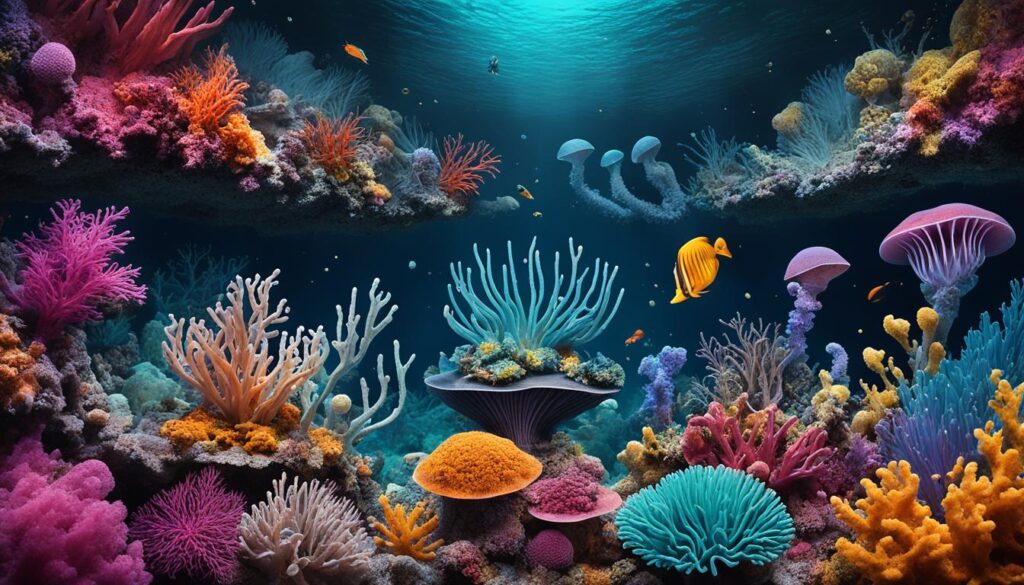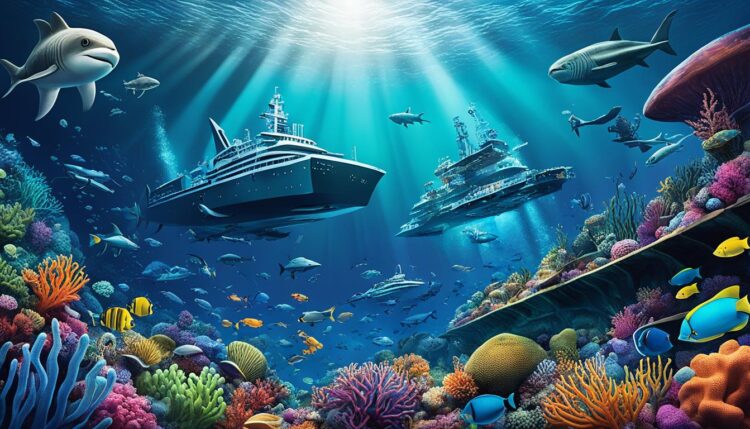Marine biology stands as a captivating field of science dedicated to the vast, largely unexplored expanses of the ocean, which constitutes more than 70% of Earth’s surface. Engaging in marine science is not solely an academic pursuit; it is a profound journey into understanding the varied life forms that inhabit the ocean, from minute plankton to massive whales. This realm of exploration aids in unveiling marine ecosystems that are critical for environmental protection and our biological heritage.
Key Takeaways
- Marine biology explores vast and relatively unexplored ocean territories.
- Marine science is crucial for understanding the diversity of marine life.
- Marine ecosystems play a vital role in environmental protection.
- Oceans cover more than 70% of the Earth’s surface.
- Conservation efforts are essential for safeguarding our biological heritage.
The Ocean’s Hidden Treasures
Despite the ocean’s vast expanse and many unexplored areas, it hosts a rich variety of marine biodiversity. Sunlit zones and dark abyssal plains, each with unique conditions, harbor countless aquatic species that have evolved to thrive in their respective environments. Advanced technology, including sonar mapping and submersibles, continues to reveal these hidden ecological niches, making us aware of the intricate web of life within various ocean zones.
The Uncharted Depths
The uncharted depths of the ocean hold some of the greatest mysteries of marine biodiversity. These deep-sea environments are home to some of the most unique aquatic species, which have adapted to extreme conditions such as high pressure, low temperatures, and complete darkness. Technological advancements have enabled scientists to explore these otherwise inaccessible zones, uncovering new species and understanding their adaptations. These discoveries emphasize the importance of studying and preserving these hidden treasures of the ocean.
Biodiversity Beneath the Waves
Marine biodiversity beneath the ocean’s surface is remarkable, with countless aquatic species populating different ocean zones. From vibrant coral reefs teeming with life to the mysterious creatures of the deep sea, each zone supports a unique ecosystem. Coral reefs, known as the “rainforests of the sea,” are especially rich in biodiversity. Studying these diverse ecosystems not only helps us appreciate their beauty but also underscores the need for conservation efforts to protect these vital marine habitats.
A Symphony of Life: Exploring Ocean Zones
Marine biology reveals a fascinating orchestration of life spanning diverse marine zones. Each zone harbors distinct organisms contributing to the rich tapestry of the ocean’s biodiversity. From the light-drenched surface to the pitch-black depths, a plethora of unique life forms thrives in these varying environments.
The Sunlit Surface Waters
The sunlit surface waters, also known as the epipelagic zone, teem with an abundance of life. This layer extends to about 200 meters below sea level and is characterized by ample sunlight, which supports photosynthesis. Consequently, it is home to a wide array of marine species, including plankton, fish, and larger predators such as sharks and dolphins.
The Mysterious Midwaters
The midwaters, or mesopelagic zone, are shrouded in mystery. Extending from 200 meters to about 1,000 meters, this zone receives minimal light, creating a unique habitat for bioluminescent organisms. Oceanic stratification within this zone contributes to distinct ecological niches that sustain various species like squid and certain deep-sea fish.
The Dark Abyss
Below the mesopelagic zone lies the abyssopelagic zone, often referred to as the dark abyss. This region stretches from 1,000 meters to the ocean floor and is characterized by perpetual darkness and high pressure. Despite the harsh conditions, abyssal species such as giant squids, anglerfish, and specialized microorganisms thrive here, demonstrating the adaptability of life in extreme marine zones.
| Oceanic Zone | Depth Range | Characteristics | Notable Species |
|---|---|---|---|
| Sunlit Surface Waters (Epipelagic) | 0-200 meters | Ample sunlight, high biodiversity | Plankton, Fish, Sharks, Dolphins |
| Mysterious Midwaters (Mesopelagic) | 200-1,000 meters | Minimal light, bioluminescent organisms | Squid, Deep-sea Fish |
| Dark Abyss (Abyssopelagic) | 1,000 meters to ocean floor | Perpetual darkness, high pressure | Giant Squids, Anglerfish |
Marine Biology
Marine biology is an intricate and fascinating field within the broader discipline of marine science. It focuses on understanding the diverse life forms that inhabit our oceans, which cover over 70% of Earth’s surface. Marine biologists delve into the unique adaptations and behaviors of marine species, exploring how these creatures thrive in various aquatic ecosystems.
Integral to oceanography, marine biology involves studying the interactions between these organisms and their environments. This research is crucial for uncovering the delicate balance that sustains marine life and offers invaluable insights into sustainable practices necessary for conserving our oceans.
One of the most exciting aspects of marine biology is its potential impact on human health. Researchers are continually discovering new medicinal compounds derived from marine organisms, such as sponges and certain bacteria, which have shown promise in treating diseases. These discoveries highlight the importance of preserving the oceans’ biodiversity.
Moreover, the study of aquatic ecosystems includes examining the physical, chemical, and geological aspects of the ocean that influence marine life. By understanding these factors, scientists can better predict how changes in the environment, such as climate change, will impact marine species and their habitats.
To provide a more comprehensive look at the importance of marine biology, here are some key aspects:
| Aspect | Details |
|---|---|
| Species Interactions | Studying predator-prey relationships, symbiosis, and competition. |
| Adaptations | Exploring physiological and behavioral adaptations to marine environments. |
| Conservation | Developing strategies to protect endangered species and habitats. |
| Medicinal Research | Discovering new drugs and treatments from marine organisms. |
| Sustainability | Promoting sustainable fishing and marine resource management. |
The intricate tapestry of life in the oceans, studied through marine science and oceanography, continues to reveal the wonders of aquatic ecosystems and their profound significance to our planet and future wellbeing.
Sponges and Corals: Guardians of the Reef
Coral reefs are crucial for maintaining marine biodiversity, acting as the bedrock for vibrant aquatic ecosystems. The interdependency of marine life on coral reefs highlights their significance in promoting aquatic resilience.
Importance of Coral Reefs
Coral reefs, often referred to as the “rainforests of the sea,” are vital in sustaining reef ecosystems. They provide shelter and nutrients for a myriad of marine species. Moreover, these reefs act as natural barriers, protecting coastal areas from wave erosion, flooding, and storms.
Unique Adaptation of Sponges and Soft Corals
Sponges and soft corals exhibit extraordinary adaptations that are essential for coral conservation. Sponges filter vast amounts of water, removing bacteria and recycling nutrients. This process enhances water quality and supports the overall health of the reef ecosystems.
- Filtration: Sponges filter up to 20,000 times their own volume in water daily.
- Nutrient Cycling: They recycle nutrients that algae and other marine organisms rely on.
Soft corals, with their flexible and often colorful structures, also contribute significantly to aquatic resilience. They offer habitats and spawning grounds for various marine life forms, ensuring the biodiversity and longevity of reef ecosystems.
Marine Mammals: Majestic Beings of the Sea
The ocean is home to a range of extraordinary marine mammals. These magnificent creatures, including the gargantuan whales, highly intelligent dolphins, and playful seals and sea lions, are not just icons of marine biology but are also crucial for maintaining ecological balance. Their roles as both predators and prey ensure the health and sustainability of marine ecosystems.
Whales: Giants of the Ocean
Whales, the largest of all marine mammals, captivate the imagination due to their impressive size and mystical presence. These cetaceans include species like the blue whale, which can grow up to 100 feet long. Whales play a vital role in marine environments by influencing the population dynamics of their prey and contributing to nutrient recycling through their fecal matter.
Dolphins: Intelligent and Playful Creatures
Dolphins, renowned for their intelligence and playful behavior, are among the most beloved marine mammals. Species like the bottlenose dolphin demonstrate advanced problem-solving abilities and complex social structures. Their interactions with humans highlight their cognitive capabilities and underscore the necessity of pinniped conservation to protect these extraordinary animals.
Seals and Sea Lions
Seals and sea lions, often referred to as pinnipeds, are unique marine mammals known for their agility both underwater and on land. They are essential to the marine ecosystem, contributing significantly to the food web. Successful pinniped conservation efforts ensure the continued survival of these species, which are critical for maintaining the balance of marine biodiversity.
| Marine Mammal | Key Characteristics | Conservation Status |
|---|---|---|
| Whales | Largest marine mammals, essential for nutrient recycling | Varies by species (e.g., Blue whale: Endangered) |
| Dolphins | Highly intelligent, complex social structures | Varies by species (e.g., Bottlenose dolphin: Least Concern) |
| Seals and Sea Lions | Agile in water and on land, critical for food web balance | Varies by species (e.g., Hawaiian monk seal: Endangered) |
Hydrothermal Vent Communities
Hydrothermal vents, located along mid-ocean ridges, are unique deep-sea ecosystems. These ecosystems thrive in complete darkness and extreme temperatures, showcasing the remarkable adaptability of life in such harsh conditions. The organisms residing around these vents form an extraordinary community, relying on chemical energy rather than sunlight.
Deep-Sea Ecosystems
The deep-sea biodiversity found around hydrothermal vents is truly astounding. These environments host extremophiles, organisms adapted to survive in sub-zero temperatures, crushing pressures, and toxic surroundings. Among the most iconic inhabitants are tube worms and giant clams, which form symbiotic relationships with chemosynthetic bacteria.

Chemosynthesis: Life Without Sunlight
Unlike most forms of life that depend on sunlight for energy, hydrothermal vent communities use a process called chemosynthesis. Bacteria convert chemicals like hydrogen sulfide into organic molecules, providing a food source for a variety of extremophiles. This fascinating process enables life to flourish in one of the most hostile environments on Earth.
| Feature | Hydrothermal Vents Ecosystem |
|---|---|
| Primary Energy Source | Chemosynthesis |
| Common Inhabitants | Tube Worms, Giant Clams |
| Environmental Conditions | High Pressure, Extreme Temperatures |
| Unique Characteristics | Deep-Sea Biodiversity, Extremophiles |
The Hadal Zone: Earth’s Last Frontier
The hadal zone represents one of the most enigmatic and least explored regions of our planet. These oceanic trenches, characterized by their extreme depth and pressure, offer a unique environment for deep-sea exploration.
Life in Extreme Pressures
Despite the immense pressure and frigid temperatures, life flourishes in the hadal zone. Organisms like amphipods and snailfish have adapted to survive in such harsh conditions, revealing the resilience of marine life. This ability to thrive has left scientists in awe, prompting further deep-sea exploration to understand these biological marvels.
Exploring the Mariana Trench
The Mariana Trench, the deepest part of Earth’s oceanic trenches, serves as a primary site for studying the hadal zone. Here, researchers have discovered a multitude of species that challenge our understanding of life’s limits. The trench’s unique environment continues to be a focal point for deep-sea exploration, offering potential insights into the adaptations necessary for survival under extreme conditions.
Bioluminescence: Nature’s Light Show
Bioluminescence serves as one of the most mesmerizing oceanic light phenomena in marine biology. This natural light display is produced by various bioluminescent species, including jellyfish, plankton, and certain types of fish. These marine creatures utilize light for multiple purposes, such as predation, defense, and communication.
The capability to emit light is an incredible marine adaptation that offers numerous benefits. In the case of predation, some bioluminescent species can lure prey using their glow. Conversely, other marine organisms use bioluminescence as a defense mechanism, confusing or startling potential predators away. Communication through bioluminescence allows species to signal each other, facilitating mating or warning of danger.
The biochemical mechanisms behind bioluminescence have captured the interest of scientists for years. The potential applications of this phenomenon extend beyond marine biology and into the realm of biotechnology and medicinal innovation. Comprehensive research is being conducted to understand how these organisms produce light and how this might be harnessed for human benefit.
| Bioluminescent Species | Functions | Examples |
|---|---|---|
| Jellyfish | Predation, Defense | Aequorea victoria |
| Plankton | Communication, Defense | Noctiluca scintillans |
| Fish | Communication, Predation | Lanternfish |
Marine Conservation Efforts
The urgency of conserving marine ecosystems has sparked numerous initiatives aimed at ocean sustainability, ecosystem restoration, and wildlife protection. These efforts ensure the long-term health of the ocean and its diverse inhabitants.
Marine Protected Areas
Creating Marine Protected Areas (MPAs) is a critical strategy for conserving marine resources. MPAs function as sanctuaries that foster ecosystem restoration and provide safe havens for wildlife protection. By limiting human activities like fishing and tourism, MPAs help to regenerate the biodiversity intrinsic to our oceans, promoting ocean sustainability.
Sustainable Fishing Practices
Implementing sustainable fishing practices is essential for maintaining fish populations and ensuring the well-being of our oceans. Methods such as selective fishing gear and catch limits are designed to prevent overfishing while minimizing bycatch. These practices play a vital role in ecosystem restoration, ensuring the longevity and health of marine wildlife.
Public Awareness and Education
Raising public awareness and educating communities about marine conservation is indispensable for promoting ocean sustainability. Educational campaigns, community involvement programs, and school initiatives aim to inform the public about the importance of ecosystem restoration and wildlife protection. Empowering individuals with knowledge fosters responsible behavior that supports marine conservation efforts globally.
Challenges Facing Marine Ecosystems
Marine ecosystems are under severe threat due to various anthropogenic factors. These challenges threaten not only the biodiversity of the oceans but also the critical services they provide to humankind.
Climate Change and Its Effects
Climate change poses a significant climate impact on marine ecosystems. Rising sea temperatures and ocean acidification are among the most pressing issues. Increased water temperatures lead to coral bleaching and altered species distributions, while acidification negatively affects calcifying organisms like mollusks and corals. These changes threaten the intricate balance of marine life, putting entire ecosystems at risk.
Marine Pollution: A Persistent Threat
Plastic pollution is another critical issue confronting marine environments. Plastics and chemicals accumulate in marine habitats, affecting countless species, from plankton to large mammals. Microplastics have infiltrated food webs, posing severe health risks to marine animals and, indirectly, to humans. Moreover, oil spills and toxic runoff from industries exacerbate the already fragile state of marine waters.
Overfishing and Its Consequences
The overexploitation of resources through overfishing has led to the depletion of fish stocks worldwide. Many species are now on the brink of collapse, disrupting food chains and leading to the loss of biodiversity. Unsustainable fishing practices, such as trawling and bycatch, further compound this issue by indiscriminately harming non-target species, including endangered ones.
| Challenge | Impacts | Solutions |
|---|---|---|
| Climate Change | Rising sea temperatures, ocean acidification | Reduction of CO2 emissions, conservation efforts |
| Plastic Pollution | Accumulation in food webs, health risks | Improved waste management, bans on single-use plastics |
| Overfishing | Depletion of fish stocks, biodiversity loss | Sustainable fishing practices, protective regulations |
Conclusion
The exploration and study of marine biology are fundamental not only to understanding the intricate life forms and ecosystems beneath the waves but also to the essential mission of ecosystem preservation. The ocean’s unquantifiable biodiversity and unique habitats, from sunlit surface waters to the depths of the Hadal Zone, offer profound insights into the natural world and our place within it.
To secure the future of marine biology and ensure the effective conservation of our marine environments, it is crucial to merge thorough scientific research with deliberate conservation strategies and robust ocean advocacy. Protecting our oceans necessitates sustainable fishing practices, creating marine protected areas, and educating the public on the significance of marine conservation efforts. These combined actions will safeguard the health and diversity of marine life for future generations.
Moving forward, the shared responsibility to maintain the richness of our ocean ecosystems lies with each of us. Strengthened by ongoing research, collective efforts, and informed advocacy, the future of marine biology can thrive, leading to a healthier and more resilient planet. By fostering a deeper understanding and appreciation for the world’s oceans, we uplift the vital work of ecosystem preservation and champion a global movement dedicated to sustaining our natural marine treasures.











